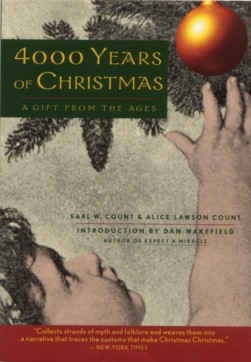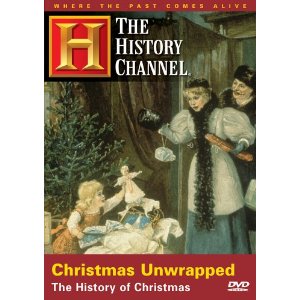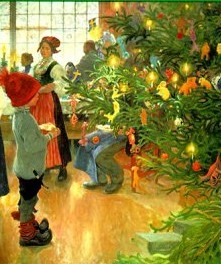|
Tracing 4000 years of Christmas around the worldAmong the things you will learn in its pages: The tradition of the Christmas tree originated with the greenery used by the Scandinavians in the middle ages to ward off the devil. Exchanging gifts started among bronze age Babylonians. -- "A lyrical treatise of the origins of our modern Yuletide practices" -- San Francisco Chronicle -- "A fascinating volume explaining how many of our modern customs are rooted in other times, cultures and faiths." -- Charlotte Observer -- "Traces the customs that make Christmas Christmas." -- The New York Times From Wakefield's introduction to the book"I REMEMBER MY FATHER playing the small foot-pedal organ in the living room of our house in Indianapolis as my mother and I stand beside him singing "O Little Town of Bethlehem". I am seven years old and I know this song and this holiday season are sacred. I feel a quiet thrill as I sing of the everlasting light that "in the dark streets shineth," Just as the light from a streetlamp down the block casts a glow through the frosted windowpanes and red, green, blue, white, and yellow lights shine from the evergreen boughs of the tree in the corner. Like millions of people before and since, I absorb the joy and the solemnity of Yuletide, when "the hopes and fears of all the years" are met on Christmas Eve. Life without it would have seemed unthinkable to me, the year routine and ordinary.
I knew as a child that Christmas was a celebration of something new coming into the world with the babe in the manger. I also knew it was accompanied by a whole panorama of song, feast, light, Santa Claus and presents. I had no idea, though, that so many of the traditions and customs I loved - the "twelve days" of Christmas, bright fires of candle flame and lights on the tree, processions of singing from house to house, feasting and giving of gifts had roots in a festival of renewal in ancient Mesopotamia two thousand years before Christ was born. As a child I believed Santa Claus (or "Saint Nick," which I thought was his name in England) was real because I saw him every year at Sears Roebuck and told him what I wanted. I helped my mother set out a "midnight supper" for him on Christmas Eve (coincidentally consisting of my father's favorite snacks when he came home from the late shift at his pharmacy), and lo and behold, the next morning the snacks were eaten and my presents were under the tree, "proof " that Saint Nicholas really was there. That's all I needed or cared to know about the subject then. Now I'm fascinated to learn that the real Saint Nicholas was the son of well-to-do Christians who lived in a province of Asia Minor in the third century, and who became archbishop of the seaport town of Myra. He inherited his family's fortune, and went to great pains to help people without letting them know he was the benefactor, "slipping gifts into the home of worthy people at night." I had no idea how varied, rich, and ancient our heritage of Christmas was until I read this gem of a book. Nor did I imagine that familiar practices performed in the small frame house where I grew up in the 1940s also had origins in Babylonian festivals and Roman revels! The survival of customs from such diverse times and cultures throughout history seem to me to a powerful testament to the universality of the human experience. It suggests that we are not only brothers and sisters under the skin, but also in time and space.
Just as we do today. "As the old year died, the rules of ordinary living were relaxed" in the households of Mesopotamia, Just as they were on Winthrop Avenue in Indianapolis when I was a boy. Then fathers came home early from work, mothers made splendid feasts, and children sang carols from house to house, where windows were lit with electric candles and colored lights on trees twinkled like lewels. "The rules of ordinary living were relaxed" to such an extent in our house that when relatives came to visit the week before Christmas, the men surreptitiously gathered in the kitchen where my father would draw a pint of bourbon from its hiding place in the broom closet and pass it around to each one for a nip and a sigh of satisfied warmth. That must have been our mild Hoosier version of the Romans' "Saturnalia," the pagan revels of excess that marked that time of the year.
4000 Years of Christmas: A Gift from the Ages I'm sure e children of faraway lands and times felt much the same awe in centuries and empires past when their minds and imagination were captured by the mystery and meaning of light. The wish to bring light to the dark, give hope of spring in the dead of winter, and a chance to renew ourselves for another year are universal human desires. Lighting the candles for Hanukkah every December symbolizes such longing in the Jewish faith. The celebration of the birth of Christ by Christians throughout the world, has blended with symbols and customs of thanks and renewal from cultures throughout history and across all borders. The richness of the story of 4000 Years of Christmas gives new meaning and pleasure to the holiday, and is itself a bountiful gift.
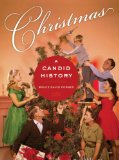
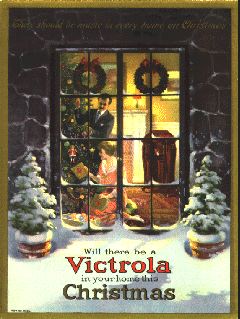
A review of another book about Christmas: Bruce David Forbes' CHRISTMAS: A CANDID HISTORY is a must read for anyone who loves the holiday season, or at least anyone who loves the religious aspect of the holiday season and enjoys the secular aspects as well. In this slim volume, Forbes looks at Christmas from its earliest incarnations to our present day celebrations. This is not a hackneyed presentation of common beliefs about Christmas. Forbes offers fresh perspectives about many commonly held theories about Christmas, especially what may be the three most common assumptions about Christmas, namely that it's a Christmas answer to winter solstice celebrations, that most of the symbols are pagan symbols with a Christian flair, and that Charles Dickens is responsible for Christmas as we know it today. For Forbes, Christmas is both all of the things and none of these things. Forbes begins by looking at the variety of winter solstice celebrations since Christmas is a winter holiday then ventures into the religious aspects, reminding readers that Easter, not Christmas was the central Christian holiday and, for that matter is still supposed to be the central Christian celebration. He then ventures into looking at Christmas symbols such as the Christmas tree, the poinsettia, St. Nicholas becoming Santa Claus, Christmas in Victorian England and the United States, and Christmas as we know it today. Throughout the book Forbes uses the analogy of a snowball as a way of explaining Christmas. If someone wishes to make a snowman, it starts as a small ball of snow, gets rolled around and picks up all sorts of things along the way: dirt, twigs, rocks, dead leaves, etc. as well as snow. The result is the large snowball that becomes the base, torso, or head of the snowman. Much of how we now celebrate Christmas started the same way. A tradition started, different cultures, peoples and time periods added something to it, and today much of what we celebrate is a combination of a variety of additions and adaptations. It turns out to be a fascinating read. As we read we learn that Christmas was never the purely spiritual holiday we sometimes imagine it to be and that there's always been a struggle to mingle the two, keeping the fun in the holiday while not forgetting it's central message. We also see how Christmas went from a religious holiday with an excuse for reveling to the family centered holiday many now celebrate. We even get a critique of modern culture and consumerism as well as glimpses into the more recent "Happy Holiday/Merry Christmas" debates. While it's not specifically a "put Christ back into Christmas" book, Forbes as a practicing Methodist and religious studies professor appreciates the primacy spiritual aspect of the holiday while also loving the more secular aspects, gives us a greater appreciation. He offers his readers insights as to what the holiday ought to be about, and in a very real way rescues Christmas.  Custom Search
|

